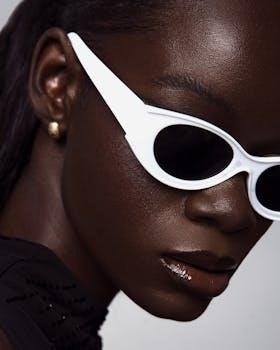earring size guide

Earrings are a versatile accessory‚ and understanding their sizes is key to comfortable wear and style. This guide helps you navigate various earring dimensions‚ ensuring the perfect fit for any occasion and piercing.
Why Earring Size Matters
Earring size significantly impacts both comfort and aesthetic appeal. An ill-fitting earring can be uncomfortable‚ leading to irritation or even infection‚ particularly with cartilage piercings. The wrong size can also detract from your overall look‚ appearing unbalanced or overwhelming your features. For instance‚ overly large hoops might not complement a petite face‚ while tiny studs might get lost on a larger earlobe. The correct size enhances your appearance‚ adding a touch of elegance and flair. Whether aiming for a subtle accent or a bold statement‚ choosing the right size ensures your earrings complement your style and personal anatomy‚ looking balanced and beautiful. Proper fit also prevents earrings from catching on clothing or hair‚ reducing the risk of damage or discomfort.

Understanding Earring Gauges
Earring gauge refers to the thickness of the earring post‚ crucial for comfortable and safe piercing. Gauges are measured numerically; a higher number indicates a thinner post‚ and a smaller number means a thicker post.
Common Gauge Sizes for Ear Piercings
Ear piercings commonly use gauges like 20G (0.8mm)‚ 18G (1mm)‚ and 16G (1.2mm). The 20G is often the starting point for earlobe piercings due to its thinness‚ and it is a standard for most earring posts‚ often found with butterfly or ball backs. The 18G is also a common size‚ while 16G tends to be used for initial cartilage piercings or for those who prefer a slightly more substantial post. Remember that the gauge refers to the thickness of the jewelry‚ not the length of the post. Understanding these common gauge sizes is essential for comfortable and safe jewelry choices. Selecting the right gauge prevents discomfort and potential problems like irritation or difficulty inserting earrings. Always consult with a professional piercer if you are unsure of the appropriate gauge for your piercings.

Types of Earrings and Their Size Considerations
Earrings come in various styles‚ including studs‚ hoops‚ and dangles‚ each with unique size considerations. This section explores how size impacts the look and comfort of each type.
Stud Earring Sizes
Stud earrings are a classic choice‚ and their size often refers to the diameter of the decorative element. Common sizes range from subtle 2mm to more noticeable 8mm or larger. The ideal stud size depends on personal preference‚ earlobe size‚ and the desired look. Smaller studs are perfect for a minimalist style‚ while larger ones can make a bolder statement. A stud earring size chart can help visualize these dimensions. Consider that earlobes come in different shapes and sizes‚ so what looks good on one person might not on another. Studs are versatile and suitable for various occasions‚ from everyday wear to formal events. It’s very important to consider the right size for your ear type. Studs typically have post lengths of 6.5mm‚ but other lengths like 5mm‚ 8mm‚ 9.5mm‚ and 11mm are available.
Hoop Earring Sizes
Hoop earrings are measured by their diameter‚ which is the distance across the circle. Sizes can range from tiny huggies (around 6mm) that closely hug the earlobe‚ to large statement hoops (over 50mm). The right hoop size depends on your personal style and face shape. Smaller hoops offer a subtle touch‚ while larger hoops create a bolder‚ more dramatic look. Consider the occasion as well; smaller hoops are suitable for everyday wear‚ whereas larger hoops might be better for special events. A visual earring size template helps determine the right hoop diameter‚ so you can curate your stack with perfect proportions. Many find it helpful to measure the inside diameter of a hoop using a ruler. Remember‚ the ideal size is also influenced by personal style and comfort.
Drop and Dangle Earring Sizes
Drop and dangle earring sizes are determined by their length from the piercing point to the bottom of the earring. These earrings come in a wide range of lengths‚ from subtle drops that barely extend past the earlobe to dramatic‚ shoulder-grazing dangles. The length you choose depends on your personal preference and the occasion. Shorter drops are often suitable for daily wear‚ while longer dangles can add flair to special events. When selecting the length‚ consider your hairstyle and neckline. A longer dangle might be obscured by long hair‚ while a shorter drop might get lost on a high neckline. Also‚ think about the visual impact you want to achieve‚ as longer earrings can create an elongating effect on the face and neck. The perfect length will enhance your overall appearance.

Measuring for Earring Size
Accurate measurements are crucial for comfortable and well-fitting earrings. This section guides you through how to measure hoop diameters and post lengths‚ ensuring you choose the right size every time.
Measuring Hoop Diameter
To measure the diameter of a hoop earring‚ you’ll need a ruler or measuring tape with millimeter or inch markings. Lay the hoop flat on a surface. Measure straight across the inside of the hoop from one inner edge to the other‚ passing through the center. This measurement gives you the hoop’s inner diameter‚ which is the most common way hoop earrings are sized. Note that the outer diameter is not used for sizing‚ so it’s important to measure the interior space. If you have a ring that fits well‚ you can measure its inside diameter and compare it to hoop sizes. This method helps you visualize the size of the hoop before purchase. Ensure that you are measuring the widest point inside the hoop‚ not from the outside edges. Remember‚ the diameter affects how the hoop hangs and its overall appearance.
Measuring Post Length
Measuring earring post length is crucial for comfort and security‚ especially for stud earrings. The post is the part that goes through your piercing. To measure it accurately‚ use a ruler or calipers. Start from the back of the frontal part of the earring to the end of the post. This measurement determines how much of the post will sit within your ear. Standard post lengths are around 6.5mm‚ but lengths can vary based on the earring design. Some posts come in lengths like 5mm‚ 8mm‚ 9.5mm‚ and 11mm. Choosing the right post length is important as a post that is too short may not be secure‚ and one that is too long might poke you. Ensure that the measurement is taken accurately for a comfortable fit.
Earring Size Guides and Charts
Using visual templates and printable charts can greatly simplify finding the right earring size. These tools provide a practical way to compare and match earring dimensions.
Using Visual Earring Size Templates
Visual earring size templates are invaluable tools for selecting the perfect earrings. These templates often showcase a range of sizes‚ typically from 10mm to 60mm for hoops‚ allowing you to see the actual scale of the jewelry. By placing the template against your ear‚ you can easily gauge how different sizes will appear. This method is particularly helpful for visualizing hoop diameter and the overall impact of various earring styles. Such templates can help avoid the hassle of ordering unsuitable sizes. Moreover‚ these visual aids often include a variety of earring types‚ giving you a comprehensive view of how stud‚ drop‚ and dangle earrings will look. This ensures you choose earrings that complement your face shape and personal style.
Printable Ring and Earring Size Charts
Printable ring and earring size charts offer a convenient way to determine your ideal jewelry measurements at home. These charts‚ often available as downloadable PDFs‚ include diagrams and rulers to help measure existing rings or ear piercings. For earrings‚ they commonly feature hoop diameter measurements and post length guides. To ensure accuracy‚ it’s essential to print the charts at the correct scale‚ following the provided instructions. By placing your existing jewelry on the chart or comparing your measurements‚ you can easily identify the correct sizes. These printable resources are particularly useful for those who prefer a tactile approach to size selection‚ ensuring a more precise fit for both rings and earrings.

Choosing the Right Size
Selecting the right earring size is crucial for comfort and style. Factors like face shape‚ piercing type‚ and occasion all play a role in making the best choice.
Earring Size and Face Shape
The size of your earrings can significantly impact how they complement your face shape; For round faces‚ longer‚ more angular earrings like dangles or drops can create a slimming effect. Conversely‚ those with more angular faces‚ such as square or heart shapes‚ may find that rounder styles like hoops or studs soften their features. It’s important to consider the overall balance; petite earrings can get lost on larger faces‚ while oversized earrings may overwhelm smaller features. Experimenting with different sizes and styles in front of a mirror will help you discover what best enhances your natural beauty and individual style. Remember‚ personal preference also plays a vital role in choosing earrings that make you feel confident and stylish. Visual templates and guides can be useful‚ but ultimately‚ trusting your own judgment is key to finding the perfect match.
Earring Size for Different Piercings
Earring size considerations vary greatly depending on the specific piercing location. For standard earlobe piercings‚ a wide range of sizes can be accommodated‚ from delicate studs to larger hoops and dangles. However‚ cartilage piercings like helix‚ tragus‚ or rook require more attention to size‚ often needing smaller‚ more precise measurements to avoid discomfort or migration. Industrial piercings‚ spanning two distinct points on the ear‚ require a specific length and gauge of barbell. Similarly‚ snug‚ daith‚ and conch piercings often need curved barbells or rings of precise dimensions. It’s crucial to choose earrings that comfortably fit the piercing without putting unnecessary pressure on the tissue. Always consult with a professional piercer for the most accurate advice regarding sizing for your unique anatomy and piercing type.